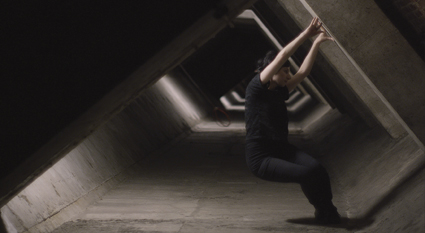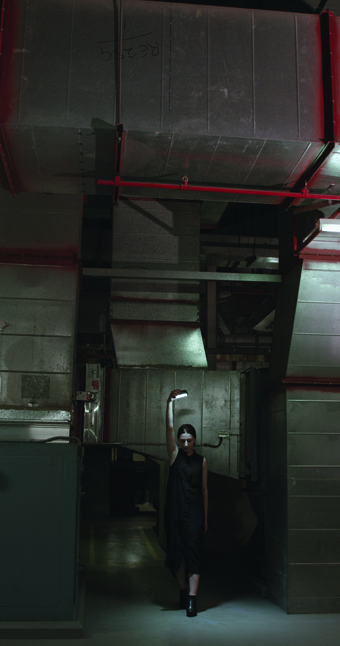Arts Centre spelunking
Urszula Dawkins: Gabriella Mangano & Silvana Mangano, Hidden Spaces, Ready Stages

Gabriella Mangano & Silvana Mangano, Hidden Spaces, Ready Stages (production still), 2013
courtesy of the artists and Anna Schwartz Gallery
Gabriella Mangano & Silvana Mangano, Hidden Spaces, Ready Stages (production still), 2013
While the freshly remodelled Hamer Hall glows, mirrors and glints at the darkening streets outside, the old BlackBox space on its Southbank concourse, re-christened the Riverhouse, remains unrenovated. It’s an apt location for a twilight reflection on the raw guts of Melbourne’s Arts Centre, titled Hidden Spaces, Ready Stages.
The multi-screen installation, with sound by James Brown, results from a two-month exploration of the Arts Centre’s labyrinthine underbelly; an environment of machine rooms, tunnels, vents and wells. On entering the gutted exhibition space, the riverside stroll and chatter recedes, replaced by sounds both harshly industrial and uncannily evocative of nature—metallic purrings, cicadas humming amid clangs and grinds. They palpate the air between four large video components around the walls that operate almost as a trompe l’oeil, bringing what lies beneath to the surface.
The largest of the video works, near monochrome, is projected onto a stained concrete wall between two enormous, half-jackhammered pillars. A slow pan reveals curved aluminium vents and supporting frames, pipes and sprayed-on markings, shadowy mesh in the darkness behind. The sound rumbles, groans, hisses and taps. The camera starts to turn in curves too, the ‘pan’ seeming to track in three dimensions—it would be dizzying if not so deliberately sedate. The grain of the concrete projection surface mimics that of film—but the effect is painterly, not cinematic. A woman appears amid this study of shifting, 2D geometry. She moves a spotlight over herself to reveal not her own body so much as the depth and chiaroscuro of the surrounding space, as a long, slow swish blankets the room.

Gabriella Mangano & Silvana Mangano, Hidden Spaces, Ready Stages (production still), 2013
courtesy of the artists and Anna Schwartz Gallery
Gabriella Mangano & Silvana Mangano, Hidden Spaces, Ready Stages (production still), 2013
Another intervention takes place on the screen opposite: within a long, triangular tunnel lit sporadically by what could be cracks of daylight, a figure interacts with the inert cement walls and struts, responding to the repeating polygonal shapes around her. She adds to the geometry, rather than revealing it. There’s a discomfort to her postures—it’s as though she’s trying to ‘be’ the space and I’m reminded of Zoe Scoglio’s Rock Bodies video, in which ‘person-becomes-rock’ through a cross-fading superposition of images. The awkwardness of trying to meet the inanimate draws attention to both ‘fleshy human’ and ‘impenetrable (though now-penetrated) edifice.’
An unwieldy piece of black board in the third video both connects its exploring protagonist to the hard shapes of her surroundings and reveals the space she’s in as not-so-inert. Against a red brick wall beneath a circular cutout vent, she holds the cumbersome board horizontal, sharing its weight with a fluctuating updraught that shirrs and tugs at her clothing. The sound is uterine, evocative of the exterior, but muffled: a field of unidentifiable blurs and echoes. The appearance of colour here is a further echo of the front-window projection outside, which is not painterly but ripe and real, a split-screen study populated with lime green columns and hydraulics, splashes of orange and yellow light. In this video, again, there’s something pedestrian and awkward about a movement that tries to place itself within the hidden, mechanistic underworld, as trapped as the fluoros in their wire cages. Hands move back and forth in slowed-down clapping motion, repelled like magnets before they can meet; opening and closing or marching up and down, vaguely robotic. On the other half of the screen the camera travels, anonymous, across what’s now a landscape of terse, utilitarian forms; cables snaked and bound in hanks. This video is visible from the boardwalk, beside a noisy restaurant blaring bad pop music. I prefer to experience it from within though, reversed in slight soft-focus, in the dark; where it feels like a natural progression from the monochrome restraint and stillness of the other videos.
The guts of the theatre are traditionally hidden and the stage traditionally silent in the absence of ‘performance.’ But Hidden Spaces, Ready Stages inserts the human into the void, the artists spelunking into spaces designed never-to-be-seen-or-heard. James Brown’s pulsing, luffing, almost sexual sounds inhabit these ‘stages’ as evocatively as any operatic diva or head-slamming rock muso, seemingly sucked down through the vents from foyer to pit to boiler-room. And the curious, almost-guileless exploration and posture of the human presence in the work de-tunes the relentless chug of these spaces too, while still according them their stark predominance. These almost spectral figures create visual refrains that are subtle, intersubjective. Both straightforward and vulnerable, their presence lingers as you leave the space; living reminder of and relief from the utilitarian depths, as you step back out into the night.
Hidden Spaces, Ready Stages, Gabriella Mangano and Silvana Mangano, cinematography Tim Metherall, directors Gabriella Mangano and Silvana Mangano, sound James Brown, Arts Centre Melbourne, Riverhouse, 27 July-4 August
RealTime issue #116 Aug-Sept 2013 pg. web






